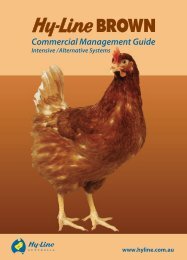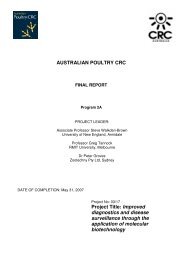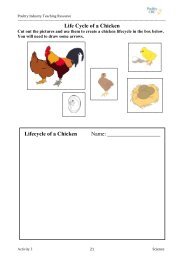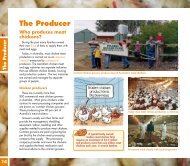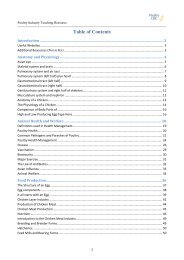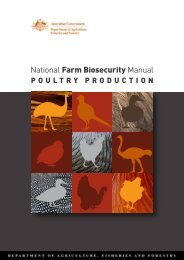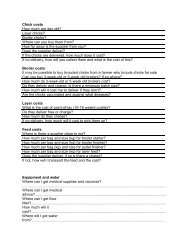Create successful ePaper yourself
Turn your PDF publications into a flip-book with our unique Google optimized e-Paper software.
The results of the current study suggest that the relative size of the gizzard is proportional to the sizeof the grain particles fed, and that the inverse is true for the proventriculus. From the literature, thestimulation of the gizzard by a coarse grain fraction in the diet or ingested coarse fibre (such as littermaterial) seems to lead to its hypertrophy, reduced gizzard erosion and shrinkage of the proventriculus(Nir et al., 1994a; Taylor and Jones, 2004; Hetland, 2007). Indeed, birds that do not have access tolitter or coarse insoluble fibre in the diet have been shown to have smaller gizzards than those that do(Deaton et al., 1973; Hetland and Svihus, 2003).It is concluded that in commercial operations, the type of litter material used may be important inmodulating gut development in broilers, which affects life-long production and health performance ofthe flock.5 Recommendations1. The plant extracts and commercial prebiotic products tested in the current study do not appear to besuitable as alternatives to IFAs in broiler diets. Although the products modulated the gut microfloracomposition of birds, this did not lead to an improvement in bird performance. The major contributionof this study to on-going research in the area is its breadth, with the evaluation of a few plant extractsand commercial products. This has laid a foundation for further studies, in which focus should bedirected at one product at a time. This will facilitate the evaluation of a range of levels ofsupplementation, and the possibility of identifying an optimal level for use in diets.2. There is a also a need for future research to elucidate the interaction between compounds that arepresent in different sources, their interactions with the gut microflora, and their effect onmacronutrient utilisation in broilers. For instance, by conducting further studies to test thedeconjugation ability of bile salts by the Lactobacillus spp. isolated and identified in the current study,one could determine their role in fat digestibility of broilers. It would also be interesting to look at howdifferent Lactobacillus spp. that were isolated in this study affect the performance of broilers in vivo.In the quest for alternatives to in-feed antibiotics, it should be considered whether combinations ofdifferent prebiotics and bioactive compounds can elicit diverse beneficial effects, exert synergisticeffects, or perhaps have negative effects. In order to screen and test the prebiotic and bioactivecompounds under clean environmental conditions, an experimental model should be developed whichtakes into account animal factors, dietary factors and management factors so that reproducible resultscan be translated to practice.3. The effects of particle size on bird performance are different for different grains. For sorghum,processing grain to an intermediate particle size improves FCR over whole grain. Improvements inthe AME of a diet by coarser grinding does not seem to be the reason for improved performance inwheat fed birds but may be one factor for improved performance of sorghum fed birds. Grain of anintermediate to coarse particle size improves the performance of broilers under experimentalconditions, and roller-milling improves FCR over hammer milling to the same particle size. There isevidence to suggest that the effect of feed texture and milling type on broiler performance and AMEmay be related to the stimulation of the digestive organs and their function.4. Feeding coarse particles in the form of the grain used in the feed can increase the relative weight ofthe gizzard, decrease proventriculus weight as well as the pH in the stomach and duodenum. Feedingwheat reduced caecal pH, and processing type (roller mill or hammer mill) did not affect organmorphology. The effect of particle size on digestive organ development and pH may influence theefficiency of the digestive processes in the broiler.6 ImplicationsThe project provides an insight into new areas of product development. Although none of the testedsupplements was effective at replacing IFAs in poultry diets, we were able to identify the plant species36



